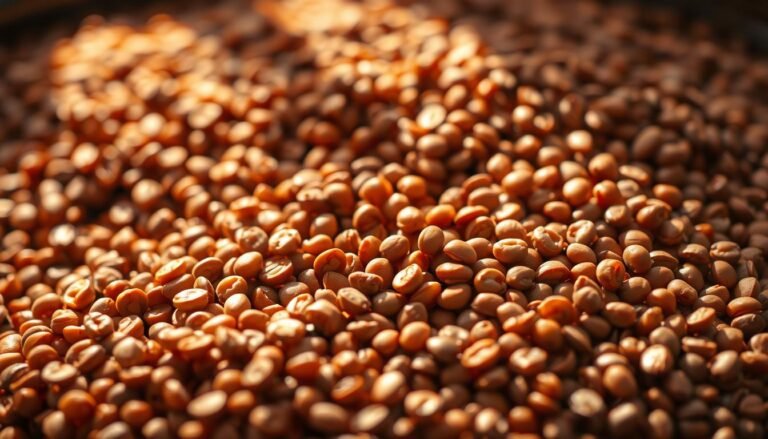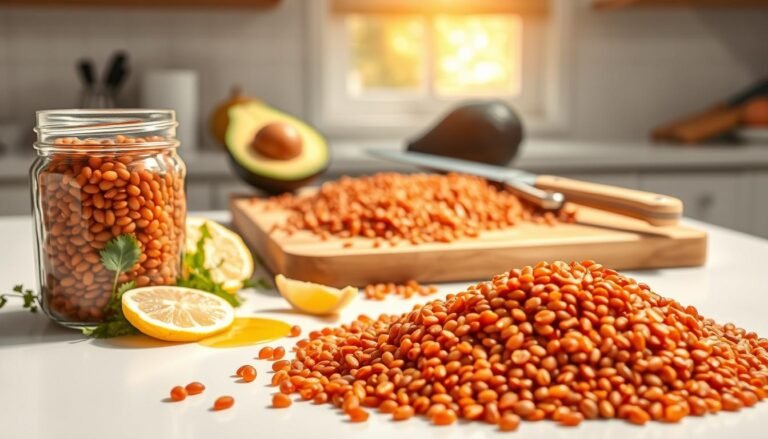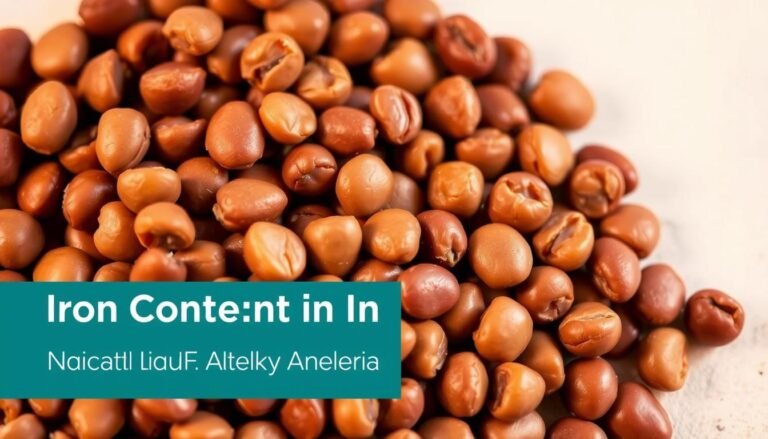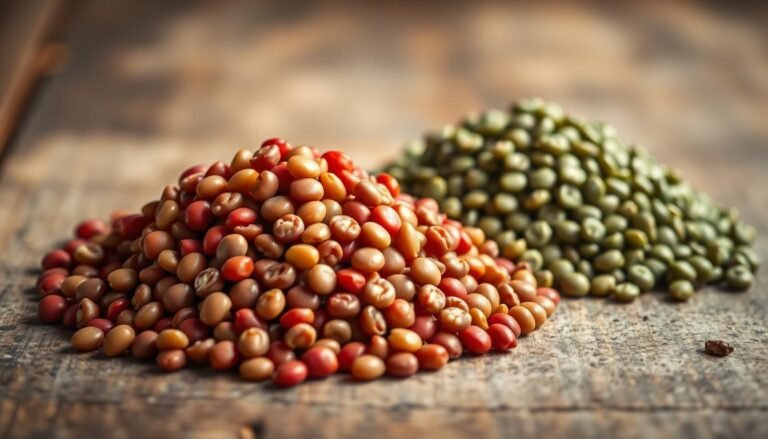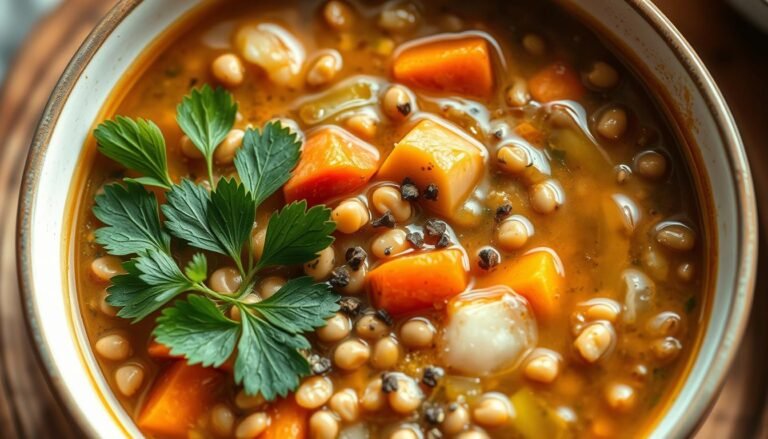Lentils are a type of legume that is closely related to beans, soybeans, peanuts, and chickpeas. They come in a variety of colors, including green, brown, red, and yellow, and are known for their high nutritional value.
Rich in protein, fiber, and essential minerals, lentils are a popular ingredient in many cuisines around the world. Whether you’re looking to improve your health, explore new recipes, or simply understand more about this versatile food, we’re here to answer your most pressing lentil questions.
Key Takeaways
- Understand the nutritional benefits of lentils
- Learn various cooking tips for preparing lentils
- Discover common myths about lentils and the facts behind them
- Explore the different types of lentils and their uses
- Get answers to frequently asked lentil questions
What Are Lentils? Understanding This Nutritional Powerhouse
Understanding lentils begins with appreciating their history and nutritional value. Lentils are a type of legume that has been a staple food globally due to their nutritional benefits and ease of storage and cooking.
The Origin and History of Lentils
Lentils have a rich history that dates back to ancient times. They were one of the first crops domesticated by humans, with evidence of their consumption found in ancient civilizations such as Egypt, Greece, and Rome. Lentils were valued for their nutritional benefits and ability to be stored for long periods.
Why Lentils Are a Global Staple Food
Lentils are a global staple due to their high nutritional value and versatility in cooking. They are rich in proteins, fibers, and various essential minerals. The table below highlights the key nutritional components of lentils.
| Nutrient | Value per 100g |
|---|---|
| Protein | 9g |
| Fiber | 7.9g |
| Iron | 3.9mg |
Lentils are also low in fat and rich in antioxidants, making them a healthy choice for people worldwide. Their ease of cooking and storage adds to their appeal as a staple food.
Types of Lentils You Should Know
Understanding the different types of lentils can elevate your cooking and nutritional intake. Lentils are a versatile ingredient, and their various forms offer a range of textures and flavors that can be leveraged in numerous dishes.
Brown Lentils: The Versatile Classic
Brown lentils are the most commonly available type and are known for their earthy flavor and firm texture. They hold their shape well after cooking, making them ideal for salads, stews, and casseroles. For more information on exploring different types of lentils, you can visit this resource.
Red and Yellow Lentils: Quick-Cooking Options
Red and yellow lentils are known for their quick cooking time and mild flavor. They tend to break down during cooking, making them perfect for soups, curries, and purees. These lentils are a great choice when you’re short on time but still want a nutritious meal.
Green Lentils: The Gourmet Choice
Green lentils have a slightly peppery flavor and retain their shape when cooked. They are often considered the gourmet choice due to their delicate taste and texture, making them suitable for salads and side dishes where you want the lentils to stand out.
Black Lentils: The Protein Powerhouse
Black lentils, also known as beluga lentils, have a robust texture and a deep, earthy flavor. They are rich in protein and fiber, making them a nutritious addition to any meal. Their striking appearance also makes them a great choice for salads and as a side dish.
By understanding and utilizing these different types of lentils, you can add variety and nutrition to your meals. Whether you’re looking for a quick cooking option or a gourmet ingredient, there’s a type of lentil that fits your needs.
Nutritional Profile of Lentils
Rich in essential nutrients, lentils are a powerhouse of health benefits, making them an excellent addition to a balanced diet. Lentils are a rich source of macro and micronutrients that are vital for maintaining good health.
Macro and Micronutrients in Lentils
Lentils are packed with a variety of nutrients that are essential for overall health. They are an excellent source of protein, fiber, and various vitamins and minerals.
Protein and Fiber Content
Lentils are renowned for their high protein and fiber content. One cup of cooked lentils provides about 18 grams of protein and 16 grams of dietary fiber, making them an ideal food for those looking to increase their protein intake without consuming meat. The high fiber content in lentils also supports healthy digestion and can help lower cholesterol levels.
Vitamins and Minerals
In addition to protein and fiber, lentils are rich in various vitamins and minerals. They are a good source of iron, folate, and potassium, among other nutrients. These micronutrients play crucial roles in energy production, healthy red blood cells, and maintaining healthy blood pressure.
Comparing Lentils to Other Protein Sources
When it comes to protein sources, lentils stand out for their nutritional benefits compared to both animal proteins and other legumes.
Lentils vs. Animal Proteins
Lentils offer a nutritious alternative to animal proteins. Unlike meat, lentils are low in fat and calories but high in fiber and protein. This makes them an excellent choice for those looking to reduce their meat intake or follow a vegetarian or vegan diet.
Lentils vs. Other Legumes
Compared to other legumes, lentils have a similar nutritional profile but with some unique advantages. For instance, lentils have a lower glycemic index compared to some other legumes, which can help in managing blood sugar levels.
| Nutrient | Lentils (1 cup cooked) | Chicken Breast (1 cup cooked) | Black Beans (1 cup cooked) |
|---|---|---|---|
| Protein | 18g | 31g | 15g |
| Fiber | 16g | 0g | 9g |
| Iron | 6.6mg | 1.1mg | 3.6mg |
Health Benefits of Eating Lentils Regularly
Lentils are a nutritional powerhouse that offers several health advantages when consumed regularly. Incorporating them into your diet can lead to significant improvements in overall health, particularly in areas such as heart health, blood sugar control, and digestive well-being.
Heart Health and Cholesterol Management
Eating lentils regularly can contribute to improved heart health by helping to manage cholesterol levels. The fiber, potassium, and antioxidants in lentils work together to support cardiovascular health, reducing the risk of heart disease. Studies have shown that a diet rich in lentils can help lower LDL (bad) cholesterol, thereby decreasing the risk of cardiovascular events.
Blood Sugar Control and Diabetes Prevention
Lentils are beneficial for blood sugar control due to their low glycemic index and high fiber content. This combination helps to slow down the absorption of glucose, preventing spikes in blood sugar levels. Regular consumption of lentils can be particularly beneficial for individuals with diabetes or those at risk of developing the condition.
Digestive Health and Fiber Benefits
The high fiber content in lentils makes them an excellent food for supporting digestive health. Fiber helps to promote regular bowel movements, prevent constipation, and support the growth of beneficial gut bacteria.
Prebiotic Properties
Lentils contain prebiotic fibers that feed the good bacteria in the gut, supporting a healthy gut microbiome. This prebiotic effect can enhance the immune system and contribute to overall well-being.
Gut Microbiome Support
By supporting the growth of beneficial bacteria, lentils play a role in maintaining a balanced gut microbiome. A healthy gut microbiome is essential for proper digestion, immune function, and even mental health.

Common Lentil Questions Answered by Nutritionists
Lentils are a versatile and nutritious food, but despite their popularity, several common questions about their health benefits and potential side effects persist. Nutritionists are often asked to provide insights into these queries, helping consumers make informed decisions about their diet.
Are Lentils Complete Proteins?
Lentils are known for their high protein content, but they are not considered complete proteins because they lack certain essential amino acids. However, when paired with grains or other protein sources, lentils can provide all the necessary amino acids, making them a valuable component of a balanced diet.
Pairing lentils with whole grains like brown rice or quinoa can enhance their protein profile, offering a complete amino acid profile.
Do Lentils Cause Bloating?
Lentils contain raffinose, a sugar that can be difficult for some people to digest, potentially leading to bloating. However, soaking lentils before cooking and gradually increasing consumption can help minimize this effect. Additionally, using spices like cumin or coriander can aid digestion.
Can Lentils Help with Weight Loss?
Lentils are rich in fiber and protein, making them very satiating and potentially beneficial for weight loss. Incorporating lentils into meals can help reduce overall calorie intake by promoting a feeling of fullness. A balanced diet that includes lentils can support weight management efforts.
By understanding the nutritional benefits and potential drawbacks of lentils, individuals can make informed choices about incorporating them into their diet, potentially enhancing overall health and well-being.
How to Cook Perfect Lentils Every Time
Lentils are a versatile ingredient, and cooking them to perfection is a skill worth mastering. Whether you’re a seasoned chef or a beginner in the kitchen, understanding the basics of lentil cooking can elevate your dishes.
Basic Lentil Cooking Methods
Cooking lentils can be accomplished through various methods, each with its own advantages. The most common techniques include stovetop, pressure cooker, and Instant Pot methods.
Stovetop Method
The stovetop method is a traditional way to cook lentils. Simply rinse the lentils, add them to a pot with enough water to cover them, and bring to a boil. Reduce the heat to a simmer and cook until tender, typically between 20-30 minutes, depending on the lentil variety.
Pressure Cooker and Instant Pot Methods
For quicker results, using a pressure cooker or Instant Pot can significantly reduce cooking time. These methods are ideal for those short on time. Cooking lentils in a pressure cooker or Instant Pot generally takes around 5-10 minutes.
Cooking Times for Different Lentil Varieties
Different types of lentils have varying cooking times. Understanding these differences is key to achieving perfectly cooked lentils.
Testing for Doneness Without Overcooking
To test if lentils are cooked, simply taste them. They should be tender but still retain some texture. Overcooking can make lentils mushy and unappetizing.
Adjusting Cooking Times for Desired Texture
The desired texture of lentils can vary depending on the recipe. Adjusting the cooking time accordingly can help achieve the perfect consistency, whether you prefer your lentils firm or soft.
By mastering these cooking techniques and understanding the nuances of different lentil varieties, you can ensure that your lentils are cooked to perfection every time.
- Always rinse lentils before cooking to remove impurities.
- Use the right water ratio to achieve the desired consistency.
- Experiment with different cooking methods to find your preference.
Common Lentil Cooking Mistakes to Avoid
To achieve perfectly cooked lentils, it’s crucial to steer clear of several common pitfalls. Cooking lentils can be a straightforward process if you’re aware of the mistakes that can lead to undercooked, overcooked, or flavorless lentils.
Skipping the Sorting and Rinsing Step
One of the most common mistakes is skipping the sorting and rinsing step. Lentils can contain debris, stones, or broken lentils that affect their cooking quality. Rinsing lentils before cooking can help remove impurities and ensure they cook evenly.
Adding Salt at the Wrong Time
Adding salt too early in the cooking process can make lentils tough. It’s recommended to add salt towards the end of cooking or after the lentils have finished cooking. This helps to season the lentils without affecting their texture.
Overcrowding the Cooking Pot
Overcrowding the cooking pot is another common mistake. Lentils need enough water to cook properly. Overcrowding can lead to uneven cooking, with some lentils being undercooked while others are overcooked. Use a large enough pot to allow lentils to cook in a single layer.
| Mistake | Consequence | Solution |
|---|---|---|
| Skipping sorting and rinsing | Debris and uneven cooking | Sort and rinse lentils before cooking |
| Adding salt too early | Tough lentils | Add salt towards the end of cooking |
| Overcrowding the pot | Uneven cooking | Use a large enough pot |
By avoiding these common mistakes, you can achieve perfectly cooked lentils every time. Whether you’re a seasoned cook or a beginner, following these tips can help you enjoy delicious and nutritious lentil dishes.
Storing Lentils: Best Practices for Longevity
Lentil storage is a crucial aspect of preserving their quality and nutritional benefits. Proper storage ensures that lentils remain fresh and retain their nutritional value for a longer period.
Dry Lentil Storage Tips
To maintain the quality of dry lentils, it’s essential to store them in a cool, dry place. Use airtight containers to keep moisture and pests out. Airtight containers or glass jars with tight-fitting lids are ideal for storing dry lentils. Ensure the storage area is away from direct sunlight and heat sources.
- Store in a cool, dry place
- Use airtight containers
- Keep away from direct sunlight and heat sources
How to Store Cooked Lentils
Cooked lentils require careful storage to prevent spoilage and maintain their texture. There are two primary methods for storing cooked lentils: refrigeration and freezing.
Refrigeration Guidelines
Cool cooked lentils quickly and store them in airtight containers in the refrigerator. They can be safely stored in the refrigerator for up to 3-5 days. Label the containers with the date to keep track of storage time.
Freezing Methods
For longer storage, cooked lentils can be frozen. Portion them into airtight containers or freezer bags, removing as much air as possible before sealing. Frozen cooked lentils can be stored for up to 6 months. Freezing helps preserve the nutritional value and texture of cooked lentils.
| Storage Method | Duration | Tips |
|---|---|---|
| Refrigeration | 3-5 days | Cool quickly, airtight containers |
| Freezing | Up to 6 months | Portion, airtight containers or freezer bags |

Versatile Lentil Recipes for Every Meal
Discover the flexibility of lentils in cooking, from breakfast staples to dinner delights. Lentils are a nutrient-rich food that can be incorporated into a variety of dishes, making them a great addition to any meal.
Breakfast Ideas with Lentils
Lentils can be a great start to the day, providing a boost of protein and fiber. Try making a lentil breakfast bowl with sautéed vegetables and a fried egg on top, or blend cooked lentils into a breakfast smoothie for a nutritious start.
“Lentils for breakfast? Absolutely!” says a renowned nutritionist, highlighting the versatility of lentils in morning meals.
Lentil Soups and Stews
Lentil soups and stews are a staple in many cuisines around the world. They are comforting, nutritious, and can be made with a variety of spices and ingredients. A simple red lentil soup can be a comforting meal on a chilly day, while a more complex green lentil stew can be a hearty dinner option.
Lentil Salads and Side Dishes
Lentils can also be used in salads and as side dishes, adding protein and texture. A lentil salad with mixed greens, cherry tomatoes, and a citrus vinaigrette makes for a refreshing lunch, while roasted lentils can be a crunchy side dish.
Australian-Inspired Lentil Recipes
Australia’s multicultural cuisine has embraced lentils in various forms. Try an Australian-inspired lentil and vegetable curry, or lentil and mushroom burgers for a twist on traditional Aussie barbecue.
International Lentil Dishes Popular in Australia
Australia’s food scene is enriched by international cuisines, including Indian, Middle Eastern, and Mediterranean dishes that feature lentils prominently. Enjoy a hearty Indian lentil curry or a Mediterranean lentil salad, both of which are popular in Australian restaurants.
“The beauty of lentils lies in their versatility and nutritional value, making them a beloved ingredient across cultures.”
Debunking Common Myths About Lentils
Lentils have been a staple in many cuisines for centuries, but despite their popularity, several myths surround their consumption. These misconceptions can deter people from enjoying the nutritional benefits of lentils. Let’s examine and debunk some of the most common myths associated with lentils.
Myth: Lentils Are Difficult to Digest
One common myth is that lentils are hard to digest. However, lentils are actually considered easy to digest when cooked properly. Rinsing and soaking lentils before cooking can significantly reduce the risk of digestive discomfort. Moreover, cooking lentils until they are tender can make their nutrients more accessible to the body.
Myth: Lentils Lack Essential Nutrients
Another myth suggests that lentils lack essential nutrients. On the contrary, lentils are rich in protein, fiber, and various vitamins and minerals. They are an excellent source of iron, folate, and potassium, making them a nutritious addition to a balanced diet. Lentils can be paired with other foods to create a complete meal that covers a wide range of nutritional needs.
Myth: Lentils Are Only for Vegetarians
Many believe that lentils are only suitable for vegetarians or vegans. However, lentils can be a valuable addition to any diet, providing a boost of protein and fiber. They can be incorporated into meat-based dishes to enhance their nutritional profile. Lentils are versatile and can be used in a variety of cuisines, making them a great option for anyone looking to diversify their meals.
Lentils for Special Dietary Needs
Lentils are a nutritional powerhouse, making them an excellent choice for individuals with special dietary needs. They offer a versatile and nutritious solution for various dietary restrictions.
Lentils in Vegetarian and Vegan Diets
Lentils are a staple in vegetarian and vegan diets due to their high protein content. They provide a valuable source of essential nutrients, making them an ideal component of plant-based meals.
Protein Complementation Strategies
Combining lentils with other plant-based foods like whole grains or nuts enhances protein quality. This strategy ensures that vegetarians and vegans consume all essential amino acids.
Iron Absorption from Lentils
The iron in lentils is non-heme iron, which is better absorbed when consumed with vitamin C-rich foods. Pairing lentils with foods high in vitamin C, such as citrus fruits or bell peppers, can enhance iron absorption.
Are Lentils Gluten-Free?
Lentils are naturally gluten-free, making them a safe choice for individuals with gluten intolerance or celiac disease. However, it’s crucial to be aware of potential cross-contamination during processing.
Cross-Contamination Concerns
Lentils may be processed in facilities that also handle gluten-containing grains, risking cross-contamination. Choosing lentil products from dedicated gluten-free facilities can mitigate this risk.
Lentils in Celiac-Friendly Diets
Lentils can be a valuable addition to celiac-friendly diets, providing essential nutrients and fiber. For more information on gluten-free diets, visit Medical News Today.
Lentils in Australian Cuisine
The use of lentils in Australian cuisine has gained popularity due to their nutritional benefits and culinary flexibility. Lentils are now a common ingredient in many Australian kitchens, adding protein, fiber, and flavor to a variety of dishes.
Popular Lentil Dishes in Australia
Lentils are incorporated into numerous Australian recipes, from hearty soups and stews to salads and curries. One popular dish is the lentil and vegetable stew, which is both nutritious and filling. Lentil salads, often mixed with fresh vegetables and herbs, are also a favorite among Australians looking for a healthy meal option.
Australian-Grown Lentil Varieties
Australia is a significant producer of lentils, with various regions cultivating different types. The country’s lentil crop includes a range of varieties, each with its unique characteristics and uses in cooking.
South Australian Lentil Farming
South Australia is particularly known for its lentil farming, with the region’s climate and soil conditions being well-suited for lentil production. Many farms in South Australia cultivate lentils, contributing significantly to the country’s overall lentil production.
Seasonal Availability and Markets
The availability of lentils can vary by season, with the harvest season typically occurring between November and January in Australia. Lentil markets in Australia cater to both domestic consumption and international export, with a focus on quality and sustainability.
| Lentil Variety | Characteristics | Culinary Uses |
|---|---|---|
| Brown Lentils | Earthy flavor, firm texture | Soups, stews, casseroles |
| Red Lentils | Mild flavor, softens quickly | Curries, dals, soups |
| Green Lentils | Delicate flavor, retain shape | Salads, side dishes, main courses |
The Sustainability Factor: Why Lentils Are Environmentally Friendly
The cultivation of lentils presents a compelling case for environmentally friendly farming practices. Lentils have been recognized for their low environmental impact, making them an attractive crop for sustainable agriculture.
Water Usage and Carbon Footprint
Lentils are known for their water efficiency, requiring significantly less water compared to other protein sources. This characteristic makes lentil cultivation particularly beneficial in water-scarce regions. Additionally, lentils have a lower carbon footprint due to their ability to fix nitrogen in the soil, reducing the need for synthetic fertilizers.
Soil Health and Crop Rotation Benefits
Lentils contribute positively to soil health through their nitrogen-fixing properties. This not only enhances soil fertility but also supports crop rotation practices, leading to more diverse and resilient agricultural ecosystems.
Nitrogen Fixation Properties
The nitrogen-fixing ability of lentils is a key factor in their sustainability. By converting atmospheric nitrogen into a form that is usable by plants, lentils reduce the reliance on chemical fertilizers, thus minimizing environmental pollution.
Sustainable Farming Practices in Australia
Australia has adopted various sustainable farming practices for lentil cultivation, including conservation tillage and crop rotation. These methods help in maintaining soil health, reducing erosion, and promoting biodiversity.
In conclusion, lentils offer a multitude of environmental benefits, from low water usage and carbon footprint to improved soil health through nitrogen fixation. As the world moves towards more sustainable agricultural practices, lentils are poised to play a significant role.
Growing Your Own Lentils: A Beginner’s Guide
Lentil cultivation is an accessible and fulfilling endeavor for home gardeners. With the right conditions and care, you can successfully grow lentils in your own backyard.
Climate and Soil Requirements
Lentils require a cool, dry climate to thrive. They prefer well-drained soil with a pH between 6.0 and 7.0. Choosing the right soil is crucial for a healthy crop. Lentils are typically grown in areas with full sun and moderate temperatures.
Harvesting and Processing Home-Grown Lentils
Harvesting lentils involves cutting the plants near the ground when the pods are dry and the seeds are hard. After harvesting, the lentils need to be dried further to reduce moisture content. Proper drying is essential to preserve the lentils for storage. Once dry, the lentils can be threshed to separate the seeds from the pods.
By following these steps, you can enjoy a bountiful harvest of home-grown lentils. Growing lentils not only provides a sustainable source of nutrition but also adds variety to your gardening experience.
Buying Guide: How to Select Quality Lentils
When it comes to buying lentils, quality matters, and knowing what to look for is crucial. With numerous options available, making an informed decision can be challenging.
What to Look for When Purchasing Lentils
To ensure you’re getting the best lentils, consider factors such as freshness and packaging. Freshness is key to maintaining the nutritional value and taste of lentils.
Freshness Indicators
Check the packaging date or the “best by” date to ensure you’re getting fresh lentils. You can also inspect the lentils for any visible signs of aging or damage.
Packaging Considerations
Lentils are often packaged in airtight bags or containers to preserve freshness. Look for packaging that is airtight and protects the lentils from moisture.
Organic vs. Conventional Lentils
Another important consideration is whether to choose organic or conventional lentils. Organic lentils are grown without synthetic pesticides or fertilizers, making them a popular choice for those seeking a more natural option.
Price Differences and Availability in Australia
Organic lentils may be pricier than conventional ones, but they offer a cleaner and more sustainable alternative. Check with local suppliers or online retailers for availability and pricing.
Pesticide Considerations
If you’re concerned about pesticide residues, opt for organic lentils or choose conventional lentils that are certified as having low pesticide residues.
Conclusion: Making Lentils a Regular Part of Your Diet
Incorporating lentils into your diet can have a significant impact on your overall health and wellbeing. With their high nutritional value and environmental sustainability, lentils are an excellent addition to a balanced diet.
Lentil benefits are numerous, from supporting heart health and managing cholesterol levels to providing a rich source of protein and fiber. By making lentils a regular part of your meals, you can experience these benefits firsthand and contribute to a more sustainable food system.
To start incorporating lentils into your diet, try experimenting with different recipes and cooking methods. From hearty lentil soups to flavorful salads, the versatility of lentils makes them easy to integrate into your daily meals. As you explore the world of lentils, you’ll discover a wealth of nutritional and culinary benefits that can enhance your overall quality of life.

